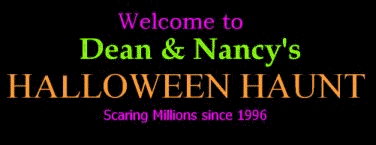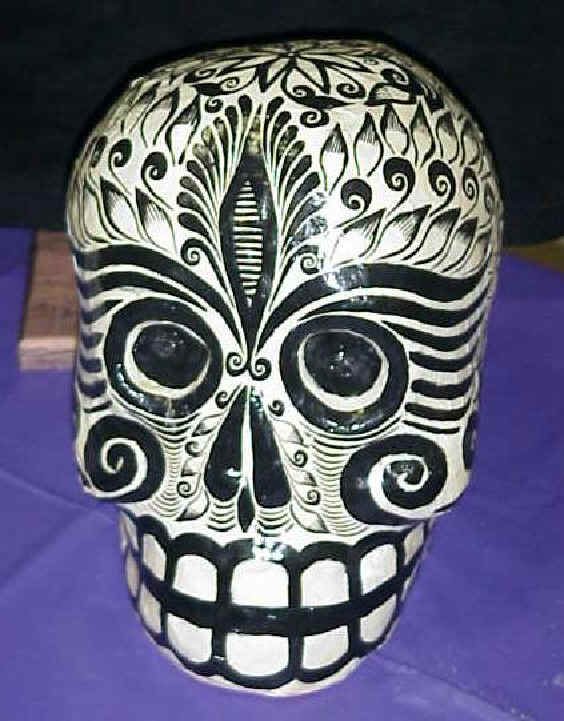
History
of Halloween
![]()
The celebration of Halloween goes back 2000 years. Celtic people celebrated Samhain on October 31st, when they believed that the ghosts of the dead came back to earth. To commemorate the event, Druids built huge sacred bonfires, where the people gathered to burn crops and animals as sacrifices to the Celtic deities. (hc)
Samhain, a Celtic word meaning "summer's end," was an ancient pagan festival worshiping the god of the dead or the dying sun. The festival marked the end of harvest and beginning of winter. To the Druids, dying crops were synonymous with the return of the dead to earth. Samhain is pronounced "sow-in" (like a cow). (cbc)
Since November first was the start of the season of death, when food grew scarce and the plants all died, it was also the night to honor the Lord of the Dead, Anwinn. The belief was that spirits of those who had died during that year also gathered that night, driven out of the bare woods and empty fields. The spirits returned to their homes and needed the help of their kin to cross over to the land of the dead. Relatives would hollow out turnips and gourds and use them to carry the spirits to the proper location. Not just good spirits were loose on Samhain - evil spirits, witches and goblins also roamed the earth. To protect your relative's spirit, you'd paint a scary face on the gourd to chase the evil spirits away. And to play it safe, you'd also disguise yourself by painting your face with hideous paints and donning a wild costume. (dcls)
 Bonfires
were very popular part of the ceremony in the Celtic countries. In Ireland,
the fires were all allowed to go out. A large bonfire was lit in the
center of town and sacrifices were thrown in. From this one central
bonfire in each town, all the hearths and fireplaces were re lit. The
same ceremony took place in Scotland, but the Scots also believed that
you could tell the future by staring into the bonfire.
Bonfires
were very popular part of the ceremony in the Celtic countries. In Ireland,
the fires were all allowed to go out. A large bonfire was lit in the
center of town and sacrifices were thrown in. From this one central
bonfire in each town, all the hearths and fireplaces were re lit. The
same ceremony took place in Scotland, but the Scots also believed that
you could tell the future by staring into the bonfire.
Between 530-532AD, Pope Boniface 4th, desperately wanted to eliminate pagan ceremonies. Pope Boniface felt that as long as the old festivals were still celebrated, the church's control wasn't complete. He also knew that if he banned the festivals, he'd have a full blown riot on his hands. So he decided to replace the old festival with a new festival and the church created All Saints' Day, a holy day to honor all the saints. The problem with All Saints' Day was it was a holy day, not a festival. The people simply celebrated both of them. (dcls)
 As
Christian missionaries moved into Ireland, they practiced Gregory's
doctrine of "syncretism" and replaced the Celts' Samhain with All Saints'
Day (Pope Gregory III moved the observation to November 1 in the eight
century). In 998 A.D. St. Odilo, Bishop of Cluny, instituted a day of
prayer and special masses for the souls of the dead. This day became
All Souls' Day, and was set for November 2nd. In many areas All Saints'
Day and All Souls' Day celebrations merged, as in Mexico, where October
31 to November 2 became known simply as "Days of the Dead". (lm)
As
Christian missionaries moved into Ireland, they practiced Gregory's
doctrine of "syncretism" and replaced the Celts' Samhain with All Saints'
Day (Pope Gregory III moved the observation to November 1 in the eight
century). In 998 A.D. St. Odilo, Bishop of Cluny, instituted a day of
prayer and special masses for the souls of the dead. This day became
All Souls' Day, and was set for November 2nd. In many areas All Saints'
Day and All Souls' Day celebrations merged, as in Mexico, where October
31 to November 2 became known simply as "Days of the Dead". (lm)
Another day with connections to Halloween is the British Guy Fawkes Day, celebrated on November 5. Guy Fawkes was a Roman Catholic who planned to blow up the Protestant House of Parliament on November 5, 1606; luckily for the House, he was apprehended and executed. Afterwards, the anniversary of the day was celebrated by building straw effigies, entreating passersby for "a penny for the Guy", and finally burning "the Guys" in bonfires. (lm)
For the next 700 years, the Church felt it had won the battle because the Celts celebrated All Saints' Day. The Celts, on the other hand, thought they had won because they still had their holiday with the original ceremonies. Neither realized that Samhain and All Saints' Day were blurring into one holiday. By the 1500's, you couldn't separate the two anymore. Of course, by this time, no one called it All Saints' Day. Now it was All Hallows' Day. The night before All Hallows' Day was of course, All Hallows' Evening, or in the slang of the villagers, Hallowe'en.
 After
the American Revolution, Halloween still never really caught on in America.
Most of the country was farmland, and the people too far spread out
to share different celebrations from Europe. In the late 1800's, nearly
7.4 million immigrants came to America, bringing their European customs
with them. Seven hundred thousand Irish Catholics came over during the
seven-year potato famine alone. These immigrants may have brought their
customs with them, but once they saw how plentiful pumpkins were in
the New World, it didn't take them long to start hollowing out jack
O'lanterns instead of turnips.
After
the American Revolution, Halloween still never really caught on in America.
Most of the country was farmland, and the people too far spread out
to share different celebrations from Europe. In the late 1800's, nearly
7.4 million immigrants came to America, bringing their European customs
with them. Seven hundred thousand Irish Catholics came over during the
seven-year potato famine alone. These immigrants may have brought their
customs with them, but once they saw how plentiful pumpkins were in
the New World, it didn't take them long to start hollowing out jack
O'lanterns instead of turnips.
 In
1921, Anoka, Minnesota celebrated the first official city wide observation
of Halloween with a pumpkin bowl, a costumed square dance and two parades.
After that, it didn't take Halloween long to go nationwide. New York
started celebrating in 1923 and LA in 1925. By then, not only had Jack
O'Lanterns replaced the hollowed out turnips, but the disguised fairies
begging door to door had become trick or treat. (dcls)
In
1921, Anoka, Minnesota celebrated the first official city wide observation
of Halloween with a pumpkin bowl, a costumed square dance and two parades.
After that, it didn't take Halloween long to go nationwide. New York
started celebrating in 1923 and LA in 1925. By then, not only had Jack
O'Lanterns replaced the hollowed out turnips, but the disguised fairies
begging door to door had become trick or treat. (dcls)
At the turn of the century, Halloween parties for both children and adults became the most common way to celebrate the day. Parties focused on games, foods of the season, and festive costumes. Parents were encouraged by newspapers and community leaders to take anything "frightening" or "grotesque" out of Halloween celebrations. Because of their efforts, Halloween lost most of its superstitious and religious overtones by the beginning of the twentieth century. (hc)
From the 1930's to the 1970's, Halloween was primarily thought of as a night for children. However, around the 1960's, things began to change: Trick-or-treating was menaced by the suggestion that disturbed individuals were poisoning candy and putting razor blades in apples, while adult costuming gained in popularity, partly through gay culture. Today Halloween seems to have once more been largely claimed by adults as their own, as carefully supervised activities for children have replaced the festival nature of trick-or-treating. (lm)
Today, Americans spend an estimated $6.9 billion annually on Halloween, making it the country's second largest commercial holiday. (hc)
![]()
|

![]()
|
|
Thanks for Visiting!!
If you have found this information useful, please consider donating some pocket change to:
Dean & Nancy's
"Halloween
at DisneyWorld"
Pay off fund!(your purchases from our advertisers
also support this website)
Thanks !

Thanksgiving - Christmas - Easter - Valentines - Summer Parties

weakly updated HTML by Nancy M 1996-2016
www.dumptv.com
comments or feedback
Powered by PowWeb Hosting
![]()